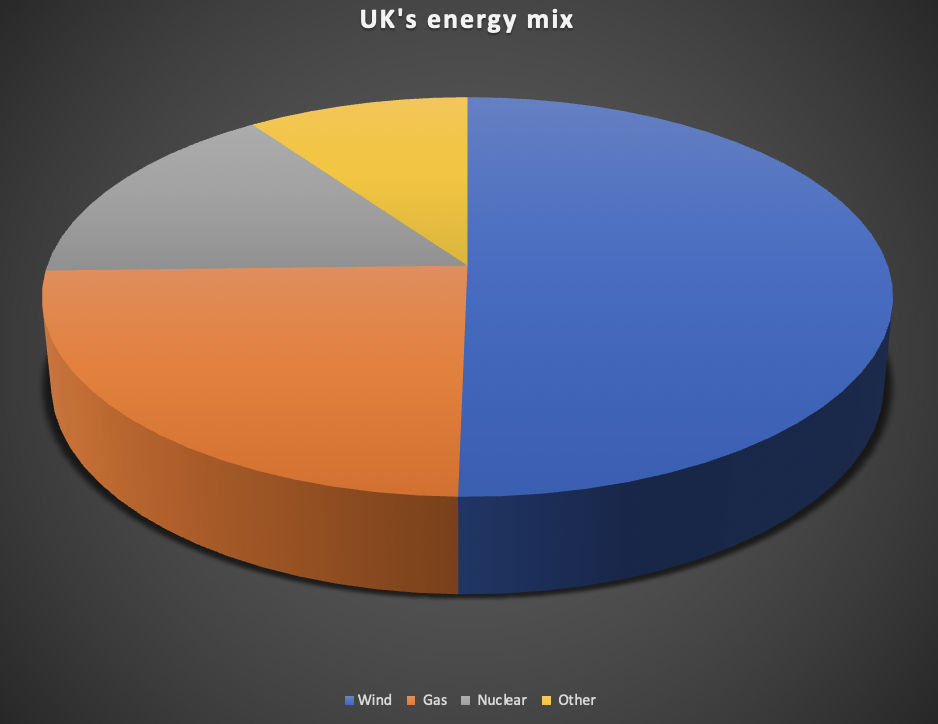Breezy does it: Wind generates 20GW for the first time ever

The UK’s offshore and onshore wind farms generated more than 20GW of power for the first time ever yesterday, revealed National Grid.
The company’s electricity system operator NGESO revealed wind generated 20.9GW of power – representing 54.9 per cent of the UK’s energy mix – during the half hour period from 12-12.30pm
It further calculated that 70 per cent of the UK’s electricity was provided by low carbon sources overall on Wednesday – including solar, nuclear and hydro alongside wind.
This is not the first time recently that the UK’s wind sector reached record-breaking levels of generation.
Last week, the UK’s offshore and onshore wind sectors generated 19.9GW between 11.30am-12pm on Wednesday 26 October.
While the latest statistics represent a new electricity generation record, the highest percentage of electricity generated from wind in a half-hour period is 64 per cent on 29 January this year.

Industry group RenewableUK argued this highlighted the success of developing wind power across the UK’s energy sector.
It also believed this would benefit households, currently facing record energy bills amid a tightening gas crisis.
Chief Executive Dan McGrail said: “This benefits hard-pressed bill-payers too, because wind has become the UK’s cheapest source of new power. It’s also strengthening our energy security at a time when generating our own electricity from home-grown sources has become vitally important”.
Holly Rowden, policy adviser at environmental think tank Green Alliance, urged the Government to harness the rapid development of wind power through backing planning reforms to make it easier to develop onshore farms and turbines.
The adviser said: “The development of wind energy across the UK has been one of the success stories of the past decade. The Government has an opportunity to unlock even more clean and cheap energy by supporting onshore wind power to lower people’s bills and support energy security.”
Energy bodies target onshore wind reforms
The UK is currently targeting 50GW of offshore wind power by the end of the decade as part of its energy security strategy.
However, Downing Street has not established any targets for onshore generation as part of its energy security strategy in April.
In her fleeting stint as Prime Minister, Liz Truss unveiled plans to bring planning in line with other infrastructure projects.
However it is unclear if new Prime Minister Rishi Sunak will commit to these changes, having already scrapped Truss’ plans to lift the fracking moratorium.
Since 2015, as part of former Prime Minister David Cameron’s push to remove ‘green crap’ from Tory policy, onshore wind development has faced a series of planning hurdles which vastly reduced development across the UK.
This means wind farms have required consent for developments to go ahead – with sites needing to be approved in plans established by residents with local authorities across England.

Developers also have to show that the proposal is located in area designated for renewable energy in a local plan.
These requirements have empowered local authorities to make decisions over what gets built in their own communities, but at the cost of onshore wind generation, which has since stagnated.
Currently, only 11 per cent of local authorities across England have designated areas for renewable developments in their plans, according to Dr Rebecca Windemer at the University of the West of England.
Her research reveals the maximum installed capacity of wind farms (in MW) granted planning permission between 2016-2021 is just 2.6 per cent of those granted permission between 2009-2014.
This is despite the UK still generating more power from onshore wind (14.2GW) than offshore wind (11.3GW).